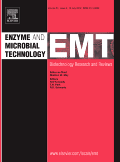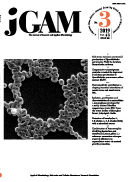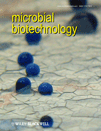
ENZYME AND MICROBIAL TECHNOLOGY
Scope & Guideline
Advancing Knowledge at the Intersection of Microbiology and Biochemistry
Introduction
Aims and Scopes
- Biocatalysis and Enzyme Engineering:
Research on the development and optimization of enzymes for various industrial applications, including biofuels, pharmaceuticals, and food processing. - Microbial Biotechnology:
Studies involving the use of microorganisms for the production of valuable compounds, bioremediation, and waste treatment. - Metabolic Engineering and Synthetic Biology:
Research focused on the modification of metabolic pathways in microorganisms to enhance the production of desired metabolites. - Environmental Biotechnology:
Exploration of microbial processes for environmental applications, such as biodegradation and bioremediation of pollutants. - Food and Pharmaceutical Applications:
Investigations into the use of enzymes and microbes in the food industry for fermentation processes, preservation, and the development of functional foods. - Structural and Functional Characterization of Enzymes:
Detailed studies on enzyme structure, mechanism of action, and interactions with substrates and inhibitors.
Trending and Emerging
- Enzyme Immobilization and Nanotechnology:
The integration of nanotechnology in enzyme immobilization techniques is a growing trend, enabling enhanced stability and reusability of biocatalysts for industrial applications. - Synthetic Biology and Modular Enzyme Systems:
Research focusing on synthetic biology, particularly the development of modular enzyme systems for complex bioconversions, is on the rise, reflecting the need for more efficient and tailored biocatalytic processes. - Microbial Consortia and Systems Biology:
Studies exploring the use of microbial consortia and systems biology approaches are emerging, emphasizing the collaborative interactions among different microorganisms to enhance biotechnological processes. - Sustainable Bioprocessing and Green Chemistry:
There is an increasing emphasis on sustainability in bioprocessing, with research focusing on green chemistry principles, waste valorization, and the use of renewable resources in enzyme applications. - Advanced Enzyme Engineering Techniques:
Emerging techniques such as directed evolution and computational modeling for enzyme engineering are gaining popularity, allowing for the design of enzymes with improved properties for specific applications.
Declining or Waning
- Conventional Fermentation Processes:
Research on traditional fermentation methods appears to be waning in favor of more innovative biotechnological approaches, such as synthetic biology and metabolic engineering. - Natural Product Extraction:
Studies focusing on the extraction of natural products using conventional methods are declining as researchers increasingly emphasize biocatalytic and enzymatic methods for improved efficiency and sustainability. - Single Enzyme Applications:
There is a noticeable reduction in studies solely focusing on the application of single enzymes, as the trend shifts towards using enzyme cocktails or multi-enzyme systems to achieve more complex transformations. - Basic Microbial Physiology:
Research that primarily explores microbial physiology without direct application to biotechnology or industrial processes is becoming less frequent, reflecting a shift towards applied research.
Similar Journals

JOURNAL OF INDUSTRIAL MICROBIOLOGY & BIOTECHNOLOGY
Exploring Innovative Solutions for a Sustainable FutureJOURNAL OF INDUSTRIAL MICROBIOLOGY & BIOTECHNOLOGY, published by Oxford University Press, is a vital resource for researchers and professionals actively engaged in the fields of applied microbiology, biotechnology, and bioengineering. With an ISSN of 1367-5435 and E-ISSN of 1476-5535, this journal has established itself as a leading platform for disseminating innovative research findings and advancing knowledge in industrial microbiology since its inception in 1996. As of 2023, it is classified in the Q2 quartile across multiple categories including Applied Microbiology and Biotechnology, Bioengineering, and Medicine, underscoring its significance in the academic community. Notably, it ranks 26th of 127 in Applied Microbiology and Biotechnology, placing it in the 79th percentile, indicative of its high impact and influence. Although it does not currently offer Open Access, it remains a key outlet for high-quality scholarly articles that align with the objectives of improving industrial practices through biotechnological applications. For those interested in the latest developments and methodologies within the realm of applied microbiology and biotechnology, this journal serves as an indispensable reference.

PREPARATIVE BIOCHEMISTRY & BIOTECHNOLOGY
Elevating scientific discourse in biochemistry and biotechnology.PREPARATIVE BIOCHEMISTRY & BIOTECHNOLOGY, published by Taylor & Francis Inc, serves as a vital platform for advancing research in the fields of biochemistry, biotechnology, and related areas of medicine. With an ISSN of 1082-6068 and an E-ISSN of 1532-2297, this journal has established itself with a notable Q3 ranking in the 2023 categories of Biochemistry, Biotechnology, and Miscellaneous Medicine, reflecting its relevance and contribution to these disciplines. The journal encompasses a wide range of topics, providing crucial insights into preparative methods, innovative biotechnological applications, and their implications for various medical advancements. Although not open access, the journal's rich content is crucial for researchers and professionals aiming to stay abreast of the latest developments and methodologies in biochemistry and biotechnology. With an enduring commitment to excellence since its inception in 1996, the journal remains an essential resource for academics and practitioners dedicated to advancing scientific knowledge and practical applications.

JOURNAL OF GENERAL AND APPLIED MICROBIOLOGY
Pioneering research that transforms our understanding of microbes.JOURNAL OF GENERAL AND APPLIED MICROBIOLOGY, published by the MICROBIOL RES FOUNDATION, is a vital resource in the fields of applied microbiology and biotechnology, as well as in diverse medical applications, serving an academic community dedicated to advancing microbial science. Established in 1955, this journal has a rich history of disseminating innovative research and insights into the intricate world of microorganisms. With an ISSN of 0022-1260 and an E-ISSN of 1349-8037, the journal maintains high scholarly standards and robustness, reflected in its 2023 Scopus rankings placing it in the Q3 and Q4 quartiles within its categories. While primarily based in Japan, the journal engages a global audience, offering valuable contributions that inform both theoretical perspectives and practical applications in microbiology. Despite being a non-open-access publication, it provides pivotal research findings essential for academics, professionals, and students alike, fostering a deeper understanding of microbial impact on health and the environment.

Microbial Cell Factories
Pioneering Research in Applied Microbiology and BiotechnologyMicrobial Cell Factories is a premier peer-reviewed journal dedicated to the field of applied microbiology and biotechnology, published by BMC in the United Kingdom since 2002. With an impressive impact factor, this journal has consistently ranked within the Q1 category across multiple disciplines, including Applied Microbiology, Bioengineering, and Biotechnology, showcasing its significance in the scientific community. The journal’s commitment to open access ensures that innovative research is freely available to researchers, professionals, and students worldwide, fostering collaboration and knowledge dissemination. With a strong presence in Scopus rankings, Microbial Cell Factories is recognized for its contributions to advancing the understanding and application of microbial processes in production systems, making it an essential resource for those involved in the microbiological and biotechnological fields.

Biochemical Engineering Journal
Advancing the Frontiers of Biochemical EngineeringBiochemical Engineering Journal, published by Elsevier, is an esteemed platform dedicated to advancing research in the fields of bioengineering, biomedical engineering, biotechnology, and environmental engineering. This journal, with ISSN 1369-703X and E-ISSN 1873-295X, has carved a niche for itself since its inception in 1998, boasting a commendable Q2 category ranking in multiple pertinent disciplines as of 2023. The journal's strong impact factor reflects its influence, with Scopus rankings placing it in the top quartiles across relevant fields including Environmental Engineering and Bioengineering. With a focus on both fundamental and applied research, it aims to inform and inspire academia and industry alike by disseminating high-quality studies, reviews, and innovative methodologies. Researchers and professionals are encouraged to explore this reputable journal to remain at the forefront of emerging trends and technologies in biochemical engineering.

Research Journal of Biotechnology
Unlocking the potential of biotechnological innovations.Research Journal of Biotechnology is a premier publication dedicated to advancing the field of biotechnology through the dissemination of impactful research articles. Published by Research Journal Biotechnology in India, this journal operates under an Open Access model, facilitating unrestricted access to high-quality research for researchers, professionals, and students worldwide. With an ISSN of 2278-4535 and an E-ISSN of 2278-4535, the journal aims to serve as a comprehensive platform for innovative studies in Applied Microbiology and Biotechnology, Bioengineering, and Biotechnology. Despite its current Q4 quartile ranking in these categories, the journal aspires to extend its influence and visibility in the academic community, aiming for greater impact in the future. The journal features research articles that span a wide array of topics in biotechnology, fostering a collaborative and knowledge-rich environment for national and international scholars. We invite you to explore, contribute to, and engage with the expanding landscape of biotechnological research through the Research Journal of Biotechnology.

APPLIED MICROBIOLOGY AND BIOTECHNOLOGY
Exploring the frontiers of microbial innovation.Applied Microbiology and Biotechnology, an esteemed journal published by Springer, serves as a vital resource in the domains of microbiology and biotechnology. With an impressive impact factor reflecting its quality, the journal holds Q1 rankings in various categories including Applied Microbiology and Biotechnology, Biotechnology, and Medicine (Miscellaneous) as of 2023. Spanning the years from 1984 to 2024, it underscores its commitment to disseminating groundbreaking research that addresses pressing challenges in health, agriculture, and environmental sustainability. The journal is rigorously indexed and holds respectable positions in Scopus rankings, notably within the top 15% of Applied Microbiology and Biotechnology and the top 15% in Biochemistry, Genetics, and Molecular Biology. Although it is not Open Access, its comprehensive articles, reviews, and short communications are indispensable for researchers, professionals, and students eager to advance their understanding and application of microbial processes and biotechnological innovations in real-world contexts.

BIOTECHNOLOGY AND BIOPROCESS ENGINEERING
Fostering Collaboration in the World of BiotechBIOTECHNOLOGY AND BIOPROCESS ENGINEERING, published by the Korean Society for Biotechnology and Bioengineering, is a prominent journal in the fields of applied microbiology, biotechnology, bioengineering, and biomedical engineering. Since its inception in 1996, this journal has served as a vital platform for researchers and professionals, facilitating the dissemination of cutting-edge research and innovative applications related to bioprocesses and biotechnology systems. With an ISSN of 1226-8372, this journal is ranked within the Q3 quartile across several categories, demonstrating its relevance and impact in the academic community. Although it operates under traditional access modalities, the journal strives to provide quality and timely insights into the advancements in bioprocess technology and microbial applications, fostering a collaborative environment for knowledge exchange. Notably, it is indexed with a respectable presence on Scopus, making it a valuable resource for students and professionals seeking the latest developments in biotechnology. For more details, kindly refer to the Korean Science Technology Center, #704 Yeoksam-Dong, Gangnam-Ku, Seoul 135-703, South Korea.

Microbial Biotechnology
Advancing microbial innovation for a sustainable future.Microbial Biotechnology, published by WILEY, stands at the forefront of innovation in the field of applied microbiology and biotechnology, showcasing cutting-edge research and advancements within both academic and industrial contexts. As an Open Access journal since 2012, it ensures that high-quality research is easily accessible to researchers, professionals, and students globally, promoting knowledge sharing and collaboration. With an impressive impact, the journal holds a Q1 ranking in its categories—Applied Microbiology and Biotechnology, Biochemistry, Bioengineering, and Biotechnology—demonstrating its significance in the scientific community. The journal currently boasts a strong Scopus ranking in several relevant disciplines, including a top 10% position in Applied Microbiology and Biotechnology, highlighting its critical role in disseminating influential findings. Designed to foster dialogue and advance technology within the microbial sciences, Microbial Biotechnology is an essential resource for anyone committed to leveraging microbial processes for sustainable and innovative solutions.

CRITICAL REVIEWS IN BIOTECHNOLOGY
Navigating the Future of Biotechnology ResearchCRITICAL REVIEWS IN BIOTECHNOLOGY, published by Taylor & Francis Ltd, stands as a leading journal in the field of biotechnology, consistently recognized for its rigorous peer-reviewed articles that impact the disciplines of Applied Microbiology, Biotechnology, and Medicine. With an impressive Q1 ranking in these categories and a significant influence reflected in its Scopus rankings—placing it within the top 5% of Applied Microbiology and the top 4% of Biotechnology journals—the journal serves as an essential resource for researchers, professionals, and students alike. Launched in 1983 and extending its coverage to encompass groundbreaking findings through 2024, it provides a rich forum for insightful reviews and innovative research that propel the field forward. Though not an Open Access journal, CRITICAL REVIEWS IN BIOTECHNOLOGY remains a vital point of reference for ongoing developments, critical analyses, and emerging trends, making it indispensable for those seeking to stay at the forefront of biotechnological advancements.